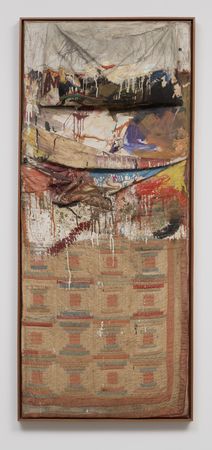This was the theme of the Contemporary QuiltArt Symposium. I thought I would share some of my thoughts on the delightful day.
Our first speaker was Robert Shaw who wrote “The Art Quilt” and the recently published Art Quilts: A Celebration.” He started by telling us that he doesn’t like the term Art Quilter or Art Quilt. When asked later, what we should call ourselves, he recommended calling ourselves artists who use fabric/textiles/quilts as our medium. I have started doing this because I find it unwieldy to try to get unknowing folks off the idea of a bed quilt that their grandmother once made them.
I digress! Robert gave us a very interesting slide show of the evolution of “art quilting.” He gave us examples of artists like Rauchenberg, Warhol and Cristo who worked with fabric. Here is the Rauchenberg piece. He reportedly ran out of materials and took the quilt and the sheets off his bed and created this piece.

He also gave examples of work by Albers, Ellsworth Kelly and Rothko which used a grid or geometric design, reminiscent of traditional quilts.
He mentioned some of the early quilters who were pushing the envelope: Joan Lintault, Therese May and Molly Upton. Of course, Nancy Crow was mentioned and he said that he had just seen her show of new work and that she is “moving voraciously forward like a shark!” Loved that comment.
Where are we going in the future? Digital, baby, digital! He specifically mentioned the new work of Michael James and the collaborative team of Gayle Fraas and Duncan Slade.
Next, we heard from Barbara Lee Smith who made the transition from city girl in Chicago to the island coast of Washington where she has learned to love and embrace “water filled air.” I was not familiar with her work. She paints lutradur which she then cuts and fuses into beautiful landscapes. She was influenced by a class that she took with Constance Howard. She does not consider herself to be a quilter. She uses no batting. She stitches her pieces from the back, using an industrial Juki. My favorite quote from her was a comment by Helen Frankenthaler, who said (in a strong NY accent) “Don’t make it gorgeous, make it good!”
After lunch, we heard from Cynthia Corbin, whose work I love. It was so much fun to see her slide show and watch how her work changed and morphed over the years. Cynthia showed us how she took the bad work and made it work — sometimes cutting it up and reassembling and sometimes, just painting or using oil sticks to change the surface. Like Ann Johnston, she now uses a long arm quilting machine. She does meticulous and heavy quilting as she found that her body could not take shoving a large quilt through a small machine.
Last on the program for Mary and I was the panel discussion with Erika Carter, Jeannette DeNicolis Meyer and Jill Nordfors Clark. They each gave a 10 minute synopsis of the evolution in their work. Again, it was fascinating to see their slides and to hear these women describe how and why their artistic endeavors changed over time. The most interesting part of the panel discussion was learning or understanding how they worked through the fallow times or of how they made leaps and changes in their work. Erika started with commercial fabrics and saw no need to use hand-dyes when others started down that path. She eventually went the route of discharging and painting fabric.
One theme of the artists who spoke to us was that at some point they stopped taking workshops and even attending shows of quilted art as they did not want to be influenced by the work of others. Finding your authentic voice as an artist requires getting in to the studio and doing the work.
